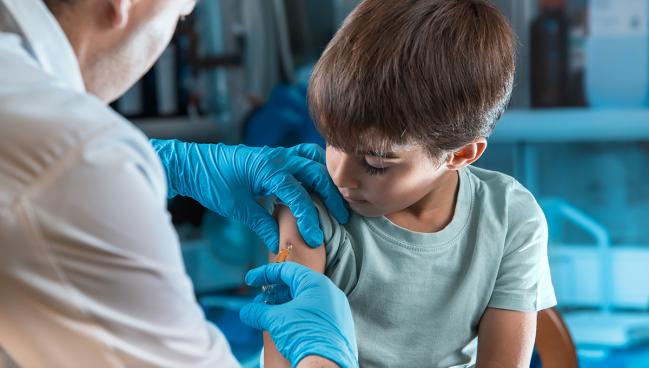Myocarditis Risk Varies by COVID-19 Vaccine Type, Dosing Interval
The complication is rare, but “you can make slight tweaks to your program to make things a little bit safer,” one researcher says.

The risk of developing myocarditis or pericarditis after receiving an mRNA-based COVID-19 vaccine is rare overall, but it does fluctuate based on factors such as vaccine type and the interval between doses, a study out of Ontario, Canada, affirms.
The complications tended to be more frequent among recipients of the vaccine from Moderna rather than the one from Pfizer/BioNTech, particularly in males and females ages 18 to 24, according to researchers led by Sarah Buchan, PhD (Public Health Ontario and University of Toronto, Canada).
In addition, the likelihood of developing myocarditis or pericarditis was much greater when the interval between the first two doses was 30 days or less, versus 56 days or more.
The findings, published online last week in JAMA Network Open, suggest that “you can make slight tweaks to your program to make things a little bit safer,” study author Jeffrey Kwong, MD (Public Health Ontario and University of Toronto), told TCTMD, referring to preferentially choosing one vaccine over another in certain age groups or extending the time between doses. He noted that in Canada, individuals younger than 30 preferentially receive the Pfizer/BioNTech shot instead of the Moderna jab. Several European countries have taken similar steps.
Kwong stressed, however, that both mRNA vaccines are safe. “The bottom line is that these are really rare side effects. We’re talking about really small numbers,” he said.
The bottom line is that these are really rare side effects. We’re talking about really small numbers. Jeffrey Kwong
A link between the mRNA vaccines and cases of myocarditis and pericarditis—clustered early after administration and in younger males—has been well established, although the events are considered rare and have typically been associated with relatively mild clinical consequences. The mechanism underlying the complication remains unknown.
To dig deeper into the epidemiology of myocarditis and pericarditis after mRNA vaccination, the investigators turned to Ontario’s COVID-19 vaccine registry and passive vaccine-safety surveillance system. The study period covered December 14, 2020, to September 4, 2021, during which more than 19.7 million doses of Moderna or Pfizer/BioNTech vaccine were administered.
Over that span, there were 297 reports of myocarditis or pericarditis that met levels 1 to 3 of the Brighton Collaboration case definitions. Most were in males (76.8%) and occurred after the second dose (69.7%) and within 7 days of the shot (73.9%). The median age of affected individuals was 24 years.
Nearly all of the events (97.6%) involved a visit to the emergency department, 70.7% required hospital admission, and 4.7% required treatment in the ICU. There were no deaths reported.
In the primary analysis focused on the period of enhanced passive surveillance for myocarditis and pericarditis, the rate of the complications tended to be higher after the second dose, particularly among recipients of the Moderna shot. The highest rate was observed in males ages 18 to 24 who received a second dose of Moderna vaccine (299.5 cases per million doses); the rate among Pfizer/BioNTech recipients in this group was 59.2 cases per million doses. The second-highest rate was seen in males ages 12 to 17 who received a second dose of Pfizer/BioNTech vaccine (97.3 cases per million).
Among people of all ages and sexes, the rate of myocarditis or pericarditis was higher when the interval between doses was 30 days or less versus 56 days or more, both with the Moderna vaccine (83.9 vs 16.2 cases per million) and the Pfizer/BioNTech shot (52.1 vs 9.6 cases per million).
Broken down by age and sex, a second dose of the Moderna vaccine was associated with a higher rate of myocarditis or pericarditis compared with a second dose of the Pfizer/BioNTech vaccine among males ages 18 to 24 (adjusted rate ratio 6.6; 95% CI 3.3-13.2) and 25 to 39 (adjusted rate ratio 5.1; 95% CI 2.3-11.5), as well as females ages 18 to 24 (adjusted rate ratio 9.6; 95% CI 1.9-48.8).
Low Risk After Both Vaccines
Commenting for TCTMD, Nicola Klein, MD, PhD (Kaiser Permanente Vaccine Study Center, Kaiser Permanente Northern California, Oakland), who co-authored an invited commentary on the study, said the higher risk of myocarditis with the Moderna versus Pfizer/BioNTech vaccine has been seen in some—but not all—prior studies. Indeed, that was shown in a recent large analysis from four Nordic countries.
The most important thing is to actually get vaccinated. The benefits definitely outweigh the risk. Nicola Klein
As for the findings around the timing of the doses, the data have been more inconsistent, and the issue has been difficult to examine in the United States because the initial recommended 3-to-4-week interval (depending on the specific mRNA vaccine) was followed pretty closely, Klein said.
Asked whether one vaccine should be recommended over the other, she said, “I think the data there is still sort of evolving.” In the US, there has not been such a recommendation, and that’s appropriate, Klein said. “Both vaccines provide good protection and there’s a low risk after both vaccines.”
The data around extending intervals between doses to lessen the risks of myocarditis and pericarditis are “fairly compelling,” she said, noting that the US Centers for Disease Control and Prevention (CDC) has acknowledged that on its website discussing clinical considerations for COVID-19 vaccination. A longer 8-week interval may make sense in certain cases, as it may reduce the risk of myocarditis, the CDC says, whereas in other situations, a shorter interval may be optimal if there is concern about a higher risk of COVID-19.
And that guidance is appropriate, Klein said. “What is does is it gives clinicians the option to take into account the issues for each patient.”
Like Kwong, Klein classified the risks of myocarditis and pericarditis after receipt of an mRNA vaccine as small, but said individuals should be aware of them. “For people who are concerned about the risk of myocarditis, [they should] talk to their providers about whether it makes sense for them to potentially extend the interval” between doses, she said.
But, she stressed, “the most important thing is to actually get vaccinated. The benefits definitely outweigh the risk, and as we are continuing to have surges and we continually want to protect individuals and these outcomes are still rare, I think that that’s the best message that should be shared with the public.”
Todd Neale is the Associate News Editor for TCTMD and a Senior Medical Journalist. He got his start in journalism at …
Read Full BioSources
Buchan SA, Seo CY, Johnson C, et al. Epidemiology of myocarditis and pericarditis following mRNA vaccination by vaccine product, schedule, and interdose interval among adolescents and adults in Ontario, Canada. JAMA Netw Open. 2022;5(6):e2218505.
Weintraub ES, Oster ME, Klein NP. Myocarditis or pericarditis following mRNA COVID-19 vaccination. JAMA Netw Open. 2022;5(6):e2218512.
Disclosures
- The study was supported by Public Health Ontario; by the Canadian Immunization Research Network through a grant from the Public Health Agency of Canada and the Canadian Institutes of Health Research; and by ICES, which is funded by an annual grant from the Ontario Ministry of Health.
- Buchan reports receiving grants from the Public Health Agency of Canada COVID-19 Immunity Task Force during the conduct of the study.
- Kwong reports receiving grants from the Public Health Agency of Canada COVID-19 Immunity Task Force and being supported by a Clinician-Scientist Award from the University of Toronto Department of Family and Community Medicine during the conduct of the study.
- Klein reports receiving grants from the CDC, Pfizer, Merck, GlaxoSmithKline, Sanofi Pasteur, and Protein Science (now Sanofi Pasteur) outside the submitted work.





Comments